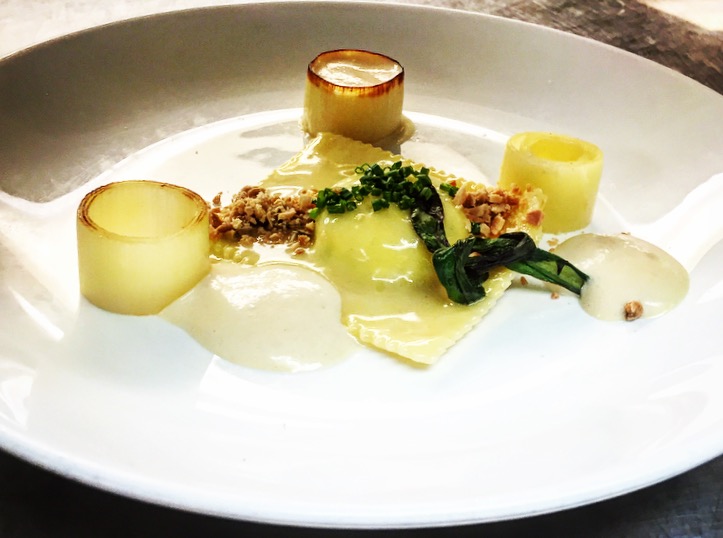 Weather is the first factor to consider when growing grapes for wine. Currently France is experiencing a climate change effecting the areas well known for wine such as Bordeaux, Languedoc, and Champagne. California is also dealing with the current drought. Soil type and structure, grape type, climate, and history of the surrounding area in which grapes come from is what makes each one individually different from any other grape. Just like fruits and vegetables, climate change is vital to grape production, and will affect the soil in which the grape grows. These attributes are otherwise known as terroir; something that acquires flavor and ambiance through soil, ground, locality, or the place it comes from. How exactly will the weather patterns of France and California effect our future wine varieties.
Weather is the first factor to consider when growing grapes for wine. Currently France is experiencing a climate change effecting the areas well known for wine such as Bordeaux, Languedoc, and Champagne. California is also dealing with the current drought. Soil type and structure, grape type, climate, and history of the surrounding area in which grapes come from is what makes each one individually different from any other grape. Just like fruits and vegetables, climate change is vital to grape production, and will affect the soil in which the grape grows. These attributes are otherwise known as terroir; something that acquires flavor and ambiance through soil, ground, locality, or the place it comes from. How exactly will the weather patterns of France and California effect our future wine varieties.
Heavy rainfall, disease, and a delay of the spring and summer seasons caused the number of grapes picked to diminish. Wine makers in France noticed that high temperatures in recent years have caused low acidity levels and high sugar levels in their grapes. Wines like this tend to become more alcoholic with higher fruit notes; many claim that it’s not very tasteful. With over 300 million plus bottles sold from Europe, chefs, restaurateurs, and sommeliers alike are concerned about the depletion of certain wine grapes in years to come. Located above Paris, Champagne is the most northern of the wine regions in France. This sparkling wine is acclaimed for its beautiful bubbly succulence; a common drink on New Year’s Eve, wedding ceremonies, and graduations worldwide. Producers of Champagne think that this region of France is comprised of different influences making theirs so special. In the near future, region will lack a third of their product during harvest due to this negative weather decline.
Due to a cold spring and current summer heatwave in France, wine production will go down by 10% says BBC News. The grapes are high in sugar and without the capability to ripen properly. This is not the first time France has seen this weather outbreak, however in the 1990s, it was also a problem for wine producers. With recent hail storms, predictors say between 7000kg and 8000kg of grapes will result. With less champagne production there could possibly be a higher demand for it over the next few months with consumers knowing that it may run out fast. Champagne France experiences hot to warm climate from July thru October and sometimes spurts of cooler climate in the beginning of fall. When the weather is warm for an extended period of time, the Champagne producer can label it as a vintage wine because it is made up of grapes from that year within the same location. Non- vintage Champagnes are produced from a few varieties of grapes grown in the same or different areas of France. But, as for California they are also experiencing negative effects in viticulture (the cultivation of grapes for producing wines).
California’s struggle with viticulture is the current drought they are experiencing. This drought is the worst it has ever been in California in 1,200 years. According to Wiley Online Library the largest wine grape region in northern America contains 1.2 million hectares of land and 18000 hectares or vineyards. This region includes Lake, Marin, Mendocino, Napa, Solano, and Sonoma. California produces almost two thirds of the United States wine and offers about 82,000 careers around the US, says Huffington Post. Wine producers are encouraged to find better methods of growing grapes so that they are not so dependent on water and can handle warmer climate. Unlike wine in France, wines in California are sold by variety not by region. Perhaps they will start to consider selling wine by region, to make it easier for the consumer to identify a wine when it goes off the market.
The world’s best wine grapes are stressed out. Climate change and varying weather conditions are on the rise all over France and California. Grape growers will have to assimilate other agricultural methods so that their crops won’t die out completely. It may only be a matter of time until the storm passes.






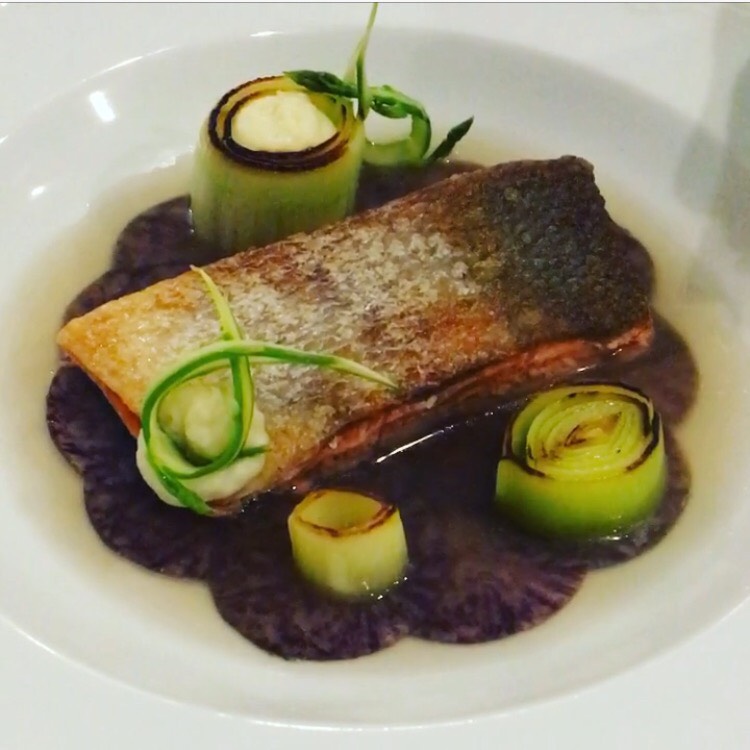 I didn't know how the purple potato would turn out in this dish with the idea I had in mind. In order to create the purple base of this plate in the manner I had previously imaged, I did a lot of tedious experimenting. It took a mandolin, 1.5 inch round cutter, and lots of patience to re- create the shape I wanted the potato to become. Accompanying the purple starch is Sockeye Salmon, charred leeks, bacon leek puree, asparagus, and bacon broth. The salmon itself was pan seared and basted with bubbly brown butter. The branded leeks echo the flavor of the leek and bacon puree that glue the asparagus tip to the fish. And, to bring everything "full circle" a table- side pour of piping hot bacon broth is added right before consumption.
I didn't know how the purple potato would turn out in this dish with the idea I had in mind. In order to create the purple base of this plate in the manner I had previously imaged, I did a lot of tedious experimenting. It took a mandolin, 1.5 inch round cutter, and lots of patience to re- create the shape I wanted the potato to become. Accompanying the purple starch is Sockeye Salmon, charred leeks, bacon leek puree, asparagus, and bacon broth. The salmon itself was pan seared and basted with bubbly brown butter. The branded leeks echo the flavor of the leek and bacon puree that glue the asparagus tip to the fish. And, to bring everything "full circle" a table- side pour of piping hot bacon broth is added right before consumption.
 Polka dots, pearls, and pot de creme is one way to keep a woman in her fifties feeling glamorous on her birthday! After a long weekend trip away for business, my mother returned home in time for a small "happy birthday" sing along before she went off to bed. Earlier in the week I asked if she either wanted her famous sour cream fudge cake or pot de creme to enjoy when she arrived home. And if I don't know my mother, she's always down for anything decadent with chocolate. But since I got no answer on either choice, I went with pot de creme in which I decided to top with whipped cream and rhubarb sugar. I admire the individual cupcake cups because they create consistent portion sizes and make way for easy cleanup. And when I clean up that just means my mom has to "clean up" after me, so I made it a bit easier on both our parts (haha)!
Polka dots, pearls, and pot de creme is one way to keep a woman in her fifties feeling glamorous on her birthday! After a long weekend trip away for business, my mother returned home in time for a small "happy birthday" sing along before she went off to bed. Earlier in the week I asked if she either wanted her famous sour cream fudge cake or pot de creme to enjoy when she arrived home. And if I don't know my mother, she's always down for anything decadent with chocolate. But since I got no answer on either choice, I went with pot de creme in which I decided to top with whipped cream and rhubarb sugar. I admire the individual cupcake cups because they create consistent portion sizes and make way for easy cleanup. And when I clean up that just means my mom has to "clean up" after me, so I made it a bit easier on both our parts (haha)!








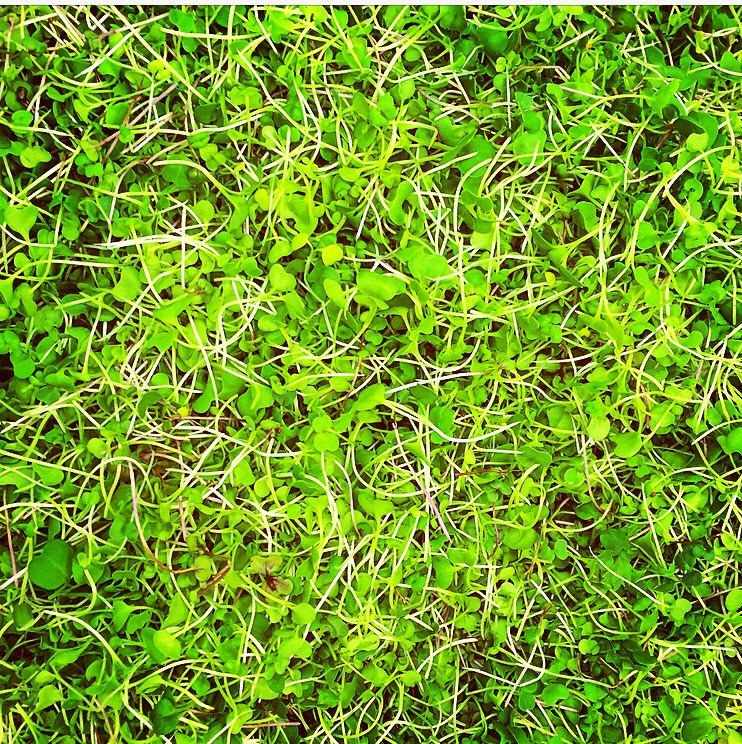 Sprout, micro, baby, mature; four vital stages in producing beautiful vegetables, fruits, and herbs. In recent years, scientists have found that micro greens are quite the super food, providing antioxidants and nutrients. In 2012, after studies from the United States Department of Agriculture were conducted, news was released stating that micro greens have increasingly higher nutritional value than that of the full grown plant. Apparently one of the best vitamins to gain in eating micros is vitamin C. For every 100 grams of micro greens, there are 20 milligrams of vitamin C. And, not to mention it’s more than twice the amount of vitamin C that would be found in tomatoes, our beloved summer fruit. Cabbage is surprisingly weighing in at 147 milligrams of vitamin C for every 100 grams of micro cabbage. And to compare that number of micros to 100 grams of full grown cabbage, there is 90 milligrams more vitamin C in the micros. Research also proved that the beta carotene (which reduces risk of eye disease) found in carrots is more nutrient dense in micro greens with 12 milligrams per 100 grams. Daikon radish micros are known for high levels of vitamin E; just a sprinkle over a salad will help you get the vitamins you need. Lastly, vitamin K produced during photosynthesis is abundant in amaranth greens, a vitamin that helps us maintain strong bones.
Sprout, micro, baby, mature; four vital stages in producing beautiful vegetables, fruits, and herbs. In recent years, scientists have found that micro greens are quite the super food, providing antioxidants and nutrients. In 2012, after studies from the United States Department of Agriculture were conducted, news was released stating that micro greens have increasingly higher nutritional value than that of the full grown plant. Apparently one of the best vitamins to gain in eating micros is vitamin C. For every 100 grams of micro greens, there are 20 milligrams of vitamin C. And, not to mention it’s more than twice the amount of vitamin C that would be found in tomatoes, our beloved summer fruit. Cabbage is surprisingly weighing in at 147 milligrams of vitamin C for every 100 grams of micro cabbage. And to compare that number of micros to 100 grams of full grown cabbage, there is 90 milligrams more vitamin C in the micros. Research also proved that the beta carotene (which reduces risk of eye disease) found in carrots is more nutrient dense in micro greens with 12 milligrams per 100 grams. Daikon radish micros are known for high levels of vitamin E; just a sprinkle over a salad will help you get the vitamins you need. Lastly, vitamin K produced during photosynthesis is abundant in amaranth greens, a vitamin that helps us maintain strong bones.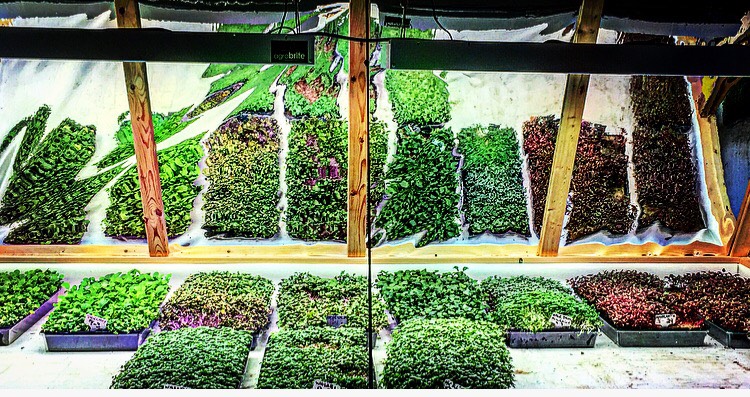
 Weather is the first factor to consider when growing grapes for wine. Currently France is experiencing a climate change effecting the areas well known for wine such as Bordeaux, Languedoc, and Champagne. California is also dealing with the current drought. Soil type and structure, grape type, climate, and history of the surrounding area in which grapes come from is what makes each one individually different from any other grape. Just like fruits and vegetables, climate change is vital to grape production, and will affect the soil in which the grape grows. These attributes are otherwise known as terroir; something that acquires flavor and ambiance through soil, ground, locality, or the place it comes from. How exactly will the weather patterns of France and California effect our future wine varieties.
Weather is the first factor to consider when growing grapes for wine. Currently France is experiencing a climate change effecting the areas well known for wine such as Bordeaux, Languedoc, and Champagne. California is also dealing with the current drought. Soil type and structure, grape type, climate, and history of the surrounding area in which grapes come from is what makes each one individually different from any other grape. Just like fruits and vegetables, climate change is vital to grape production, and will affect the soil in which the grape grows. These attributes are otherwise known as terroir; something that acquires flavor and ambiance through soil, ground, locality, or the place it comes from. How exactly will the weather patterns of France and California effect our future wine varieties.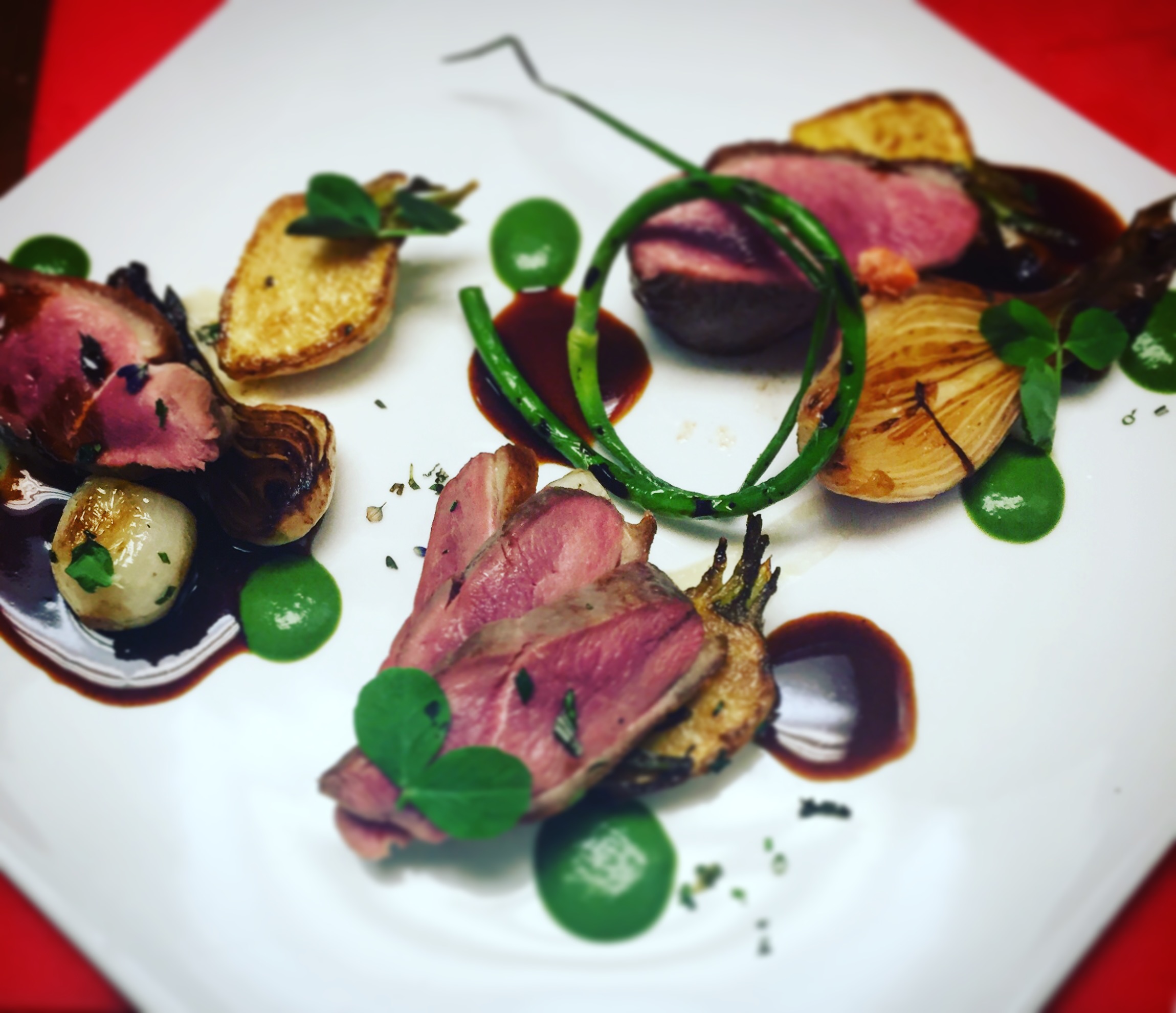 Looks like a whip, tastes like garlic, and grows where the wild things live. Garlic scapes are a member of the allium family along with shallots, chives, rakkyo, and onions. Its more common to see the scape during the summer season. Fine dining restaurants love to play around with this ingredient, making it a seasonal guest on their sophisticated summer menus. I myself have had some experience cooking and plating it, as seen in the photograph above. At my current place of work, we use the garlic scape in two ways on our duck entree.First, I blanch the scapes and blend with salt and chicken stock to make the vibrant green puree, which we dot around the plate. The other way we use the scape is by grilling it and placing it whole on the plate, which acts as the final garnish.
Looks like a whip, tastes like garlic, and grows where the wild things live. Garlic scapes are a member of the allium family along with shallots, chives, rakkyo, and onions. Its more common to see the scape during the summer season. Fine dining restaurants love to play around with this ingredient, making it a seasonal guest on their sophisticated summer menus. I myself have had some experience cooking and plating it, as seen in the photograph above. At my current place of work, we use the garlic scape in two ways on our duck entree.First, I blanch the scapes and blend with salt and chicken stock to make the vibrant green puree, which we dot around the plate. The other way we use the scape is by grilling it and placing it whole on the plate, which acts as the final garnish.